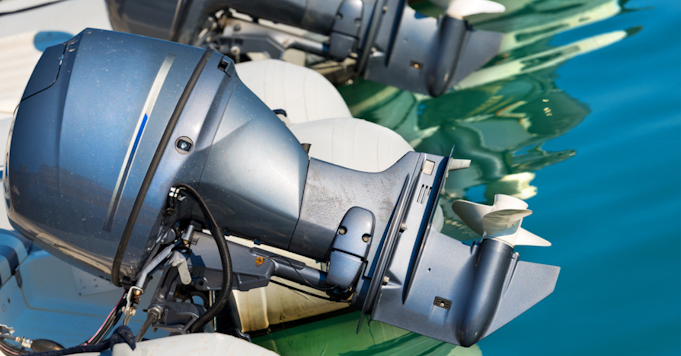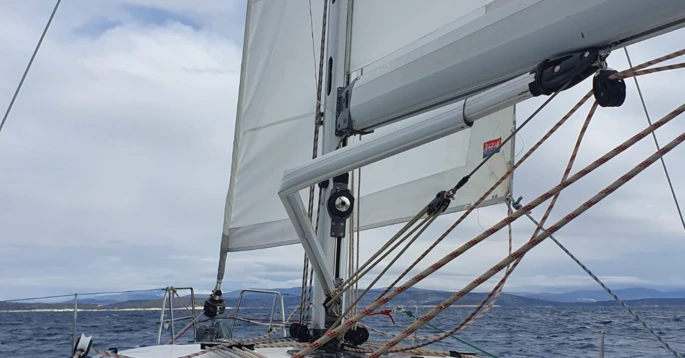Should you insure your deposit or not? There are two groups of sailors, those who never take out deposit insurance, banking on the fact that nothing will happen to the boat, and those who always take out insurance because they understand that things do happen at sea and want a good night’s sleep.
We’ve spoken to charter companies and sailors to put together a list of the most common reasons people lose their boat deposit.
- Scratched gelcoat
- Clogged toilet
- Drowned outboard motor
- Broken hatch
- Scuffed/broken rudder blade
- Lost anchor
- Torn sails
- Bent railing
- Broken kicking strap, bent boom
- Burnt out bow thruster/anchor windlass
What are the most common reasons for losing a boat deposit and how to prevent them?
Scratched gelcoat
We probably know of no one who loves manoeuvring in a harbour when it’s narrow and the wind is blowing. A scratched boat is the most common damage that can occur. Plus, during the season, there may even be situations where scraping your boat in a harbour is just not your fault, rather the fault of a careless captain of another vessel.
"Broken or damaged parts of the boat are the most common reason we retain a deposit. We mostly deal with broken railings or damage to the interior." says the base manager of Sailing Europe Charter.
Tip: You can’t affect the wind in the harbour, but you can read our article on how to handle port manoeuvres smoothly.
Clogged toilet
Rule number one is: "Never drop anything but …. down the toilet of a boat”.
Clogged toilets are cited as a significant cause of losing the deposit by charter companies such as Sailing Europe Charter.
Drowned outboard engine
Handling an outboard motor and placing it on a dinghy is always a bit tricky. Have you ever drowned a motor? You wouldn’t be the first or the last sailor to have this happen to you.
Tip: Always tie the outboard motor to the boat with one more rope and secure it on the dinghy with the help of others.

Broken hatch
The hatch is basically a window, and windows can sometimes get broken or noticeably scratched. Often the hatch is left open and the gennaker sheet gets caught behind it, upending the hinges as it turns. This was confirmed by the Greek charter company MG Yachts. Another situation cited was when the crew forgets to close the hatch before sailing and later steps on it.
Tip: Always keep hatches closed when sailing.
Scuffed/broken rudder blade
Some boats back up to the pier for too long and scrape the rudder blade on a lower part of the pier. "Never blindly trust marine pilots," advises a representative from MG Yachts.
Lost anchor
The bolt that secures the anchor should hold, but in our experience not always and while sailing, it can fall into the water. If the anchor snags on the seabed, there is often nobody on board to dive and retrieve it. These things can happen but the anchor is quite an expensive item.
The charter company Sailing forever, whose boats we offer, lists the most common reasons for losing the deposit as a lost anchor (or the whole chain when it gets snagged) and the inability to retrieve it, and a lost dinghy.
Tip: Make sure you have the anchor secured with a line. In case the anchor gets snagged, it's good to have someone on board who can dive and has goggles and fins.

Torn sails
Sails are probably the most delicate thing on a boat and on a rented boat they are never in perfect condition. Strong winds can tear a hole in the sails or rip the eye of the sheet off. And since sails are expensive, the deposit would probably be retained in full.
Tip: There's a saying among sailors, "When you think of reefing, reef, when you want to hoist the sails again, have a coffee and then hoist them, unless you've changed your mind in the meantime."
"Surprisingly, it's not that often that we get clients who destroy their sails entirely. Most of the time it is minor tears due to the sail fluttering near the furling or other sharp parts on the mast." says a representative of MG Yachts.
Bent railings
Whether from manoeuvring in the marina or just because a crew member held on too hard, the railing can be pulled off the deck or bent.
Broken kicking strap or bent boom
Both look very solid, but both can give way. The boom usually can't withstand unwanted slack, and the kicking strap can't withstand too much tension.
Tip: Don’t go all out even when you can’t help it at the regatta.

Burnt out bow thruster or anchor windlass
The tension in the bow thruster and the anchor windlass is tremendous. An experienced captain uses these carefully and never longer than necessary. Even so, these devices can still overheat and stop working.
Tip: Give them a break. Both the anchor windlass and bow thruster should be run gradually. Run briefly and then pause and then run ...
Of course, we’ve failed to mention lost or damaged minor items such as winch handles, lost fenders (I'm sure there are plenty floating in the sea), broken doors including locker doors inside, or an upturned cockpit or saloon table.
Would you like to sail a boat, insure your deposit or both?
Take a look at our range of boats
